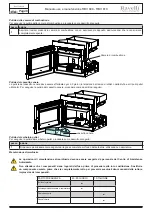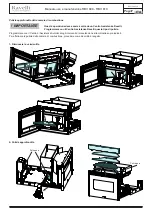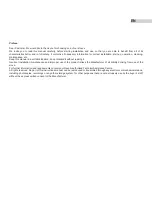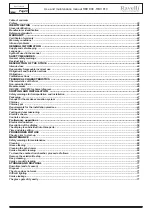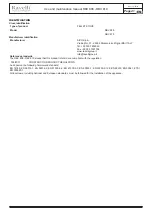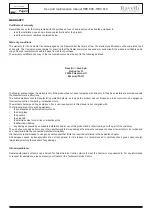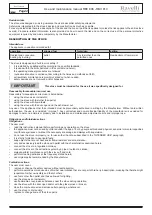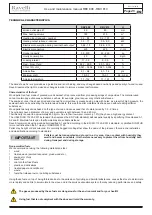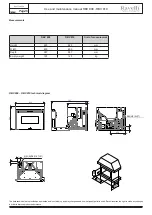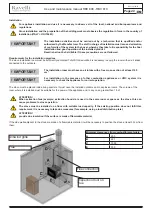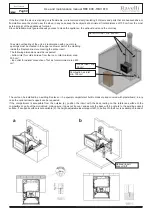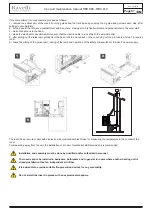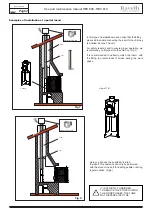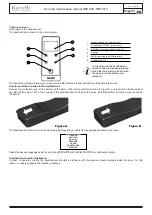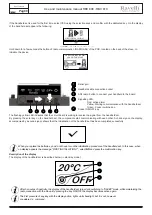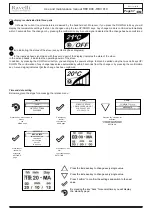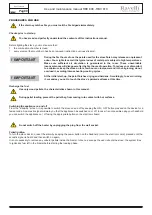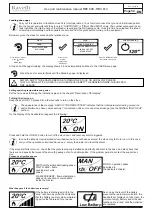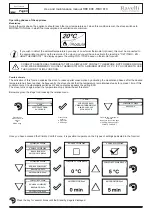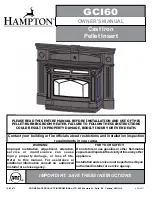
Use and maintenance manual RBV 808 - RBV 810
Page 45
Rev.1 14/02/18
EN
TECHNICAL CHARACTERISTICS
RBV 808
RBV 810
U
smoke outlet pipe Ø
80
80
mm
Max. heating volume
180
215
m
3
Heating input reduced - nominal
3,2 - 8,5
3,2 - 10,1
kW
Heating output reduced - nominal
3,0 - 7,7
3,0 - 9,0
kW
Electrical consumption during nominal heat output*
0,68 - 1,8
0,68 - 2,13
W
Electrical connection
420
420
V - Hz
Hopper capacity
50 - 230
50 - 230
kg
Hourly consumption
20
20
Kg/h
Loading interval
11 - 30
9 - 30
h
Red. - Nom. Yield
93,1 - 90,5
93,1 - 89,2
%
CO at 13% of O
2
0,021 - 0,004
0,021 - 0,004
%
Smoke flow
4,1 - 6,8
4,1 - 7,4
g/s
Minimum draft
10-0,1
10-0,1
Pa - mbar
Smoke temperature
71 - 132
71 - 157
°C
The data shown here is provided as a guideline and is not binding, and may change based on what type and quality of wood is used.
Ravelli reserves the right to make any changes in order to improve product performance.
Characteristics of the fuel
Wood pellet is a fuel made of pressed wood sawdust, often recovered from processing scraps of carpentries. The material used
cannot contain any extraneous substance such as, for example, glue, lacquer or synthetic substances.
The sawdust, once it has been dried and cleaned from impurities, is pressed using a die with holes: as a result of high pressure, the
sawdust heats up by activating the natural wood binders; this way the pellet maintains its shape even without adding artificial
substances.
Wood pellet density varies based on the type of wood and can exceed that of natural wood by 1.5 - 2 times.
The cylinders have a diameter of 6 mm and a variable length between 10 and 40 mm.
Their density is equal to approximately 650 kg/m
3
. Due to their low water content (< 10%) they have a high energy content.
The UNI EN ISO 17225-2:2014 standard (that replaces the EN PLUS standard) defines pellet quality by specifying three classes: A1,
A2 and B. Maintain fuels and other flammables at a suitable distance.
Ravelli recommends using wood pellet classified A1 and A2 according to the EN ISO 17225-2:2014 standard, or certified DIN PLUS
(more restrictive than the A1 class) or ONORM M 7135.
Pellet may be light or dark coloured, it is normally bagged into bags that show the name of the producer, the main characteristics
and classification according to standards.
! IMPORTANT
Pellets must be transported and stored in a dry area. Upon contact with humidity they
swell and become unusable: it is therefore necessary to protect them from humidity, both
during transport and during storage.
Non-permitted fuels
We recommend not using the following materials as fuel:
•
wood
•
treated wood (painted, lacquered, glued wood etc.);
•
sawdust or chips
•
liquid fuel
•
coal or other fossil fuels
•
plastic and derivatives
•
treated paper and cardboard
•
waste
•
fuels that release toxic or polluting substances
Using these fuels, on top of being forbidden due to the emission of polluting and harmful substances, causes the stove to deteriorate
more rapidly and debris to accumulate in the stove and in the smoke evacuation system, thereby reducing performance and safety.
The gases produced by these fuels are dangerous for the environment and for your health!
Using fuel that is not compliant with the above will void the warranty.
Содержание RBV 808
Страница 2: ......
Страница 171: ...DATE WORK PERFORMED MAINTENANCE...






